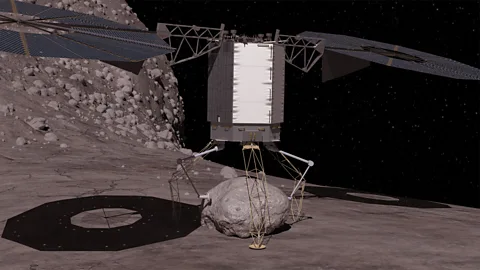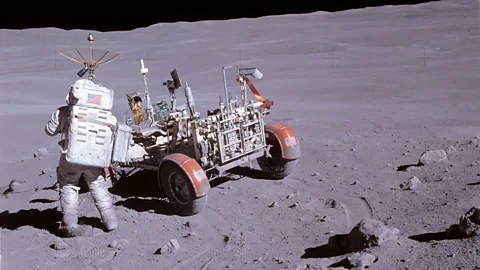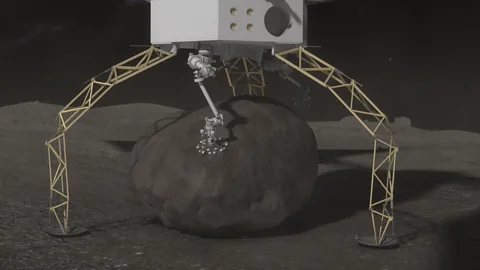The challenge of catching a floating asteroid
 Nasa
NasaNasa plans to play catch with an asteroid. Here’s how they will do it.
We all know the story – an asteroid falls to Earth and everything dies. The only higher animals to survive the ensuing nuclear winter would be fluffy, small and probably live underground. Just like the dinosaurs 65 million years ago, most humans wouldn’t stand a chance. Which brings us to Nasa’s latest project: ensnaring one of these giant, drifting rocks and sending it hurtling towards the Earth. What are they thinking?
“Right now the likely target is 2008 EZ5,” Humberto Campins, a planetary scientist and advisor for the project, says over the phone. “It’s a very descriptive name, very poetic,” he laughs.
The object he’s discussing cheerfully is an asteroid so large, it would make Tyrannosaurus rex shudder. It was discovered in 2008 (hence the name) and is between 230 and 710 metres across. If it were to slam into our planet, the resulting explosion would be up to a million times greater than the atomic bomb dropped on Hiroshima.
 Alamy
AlamyBut there’s no need to flee for the mountains just yet. In fact, Nasa isn’t hauling the whole asteroid – and they’re certainly not intending its fiery death on the surface of the Earth. Instead the plan is to pluck a single 20-ton boulder from its surface and nudge it into orbit with the Moon.
(It’s not the only asteroid mission we’re planning – watch the video below to watch how humanity will test our defence to stop an asteroid colliding with Earth.)
To put this in perspective, over the course of six missions between the late 1960s and early 1970s, Apollo astronauts brought 382kg (840lb) of Moon rocks back to Earth. That’s roughly equivalent to the weight of a large brown bear. The new mission will haul a rock comparable to at least two fully-grown T. rex – nearly 50 times heavier – in a single trip.
Add to that the fact that the asteroid is moving at 55,923mph (90,000km/h) and it usually resides up to 292 million miles (471 million kilometres) away – and you have a characteristically ambitious project. How will they pull it off? And what’s the point?
Asteroids are thought to be leftovers from the formation of our solar system; while most drifting rocks eventually collided to form the planets, those which avoided that fate have been circling the Sun for the last five billion years.
The “near-Earth” asteroids are those with erratic orbits which veer close – sometimes perilously close – towards us. No human has been killed by an asteroid in the last thousand years and no large object is set to hit the Earth in the next hundred – but there are ancient Chinese records of such deaths and as recently as 1908, an asteroid flattened an area roughly the size of Luxembourg, in the uninhabited taiga of remote Siberia. “They have hit before and it will happen again unless we prevent them,” says Campins.
 Alamy
AlamyThis proximity has upsides, too. Last year scientists watched as an asteroid packed with about $5tn (£4tn) worth of platinum scraped the Earth some 1.5 million miles away, which is little more than six times the distance from the Earth to the Moon. There’s increasing interest from private companies in mining these heavenly riches and there’s one in particular that Nasa has been hankering after: water.
While some asteroids are made mostly of metal, others – the C-type asteroids – are composed mostly of carbon mixed with water. “If we want to expand into the Solar System, in the future astronauts could use asteroids as waypoints to refuel with water and oxygen,” says Paul Chodas, manager for Nasa’s Near Earth Object centre at the Jet Propulsion Laboratory, California.
But there’s a problem. At the moment, most asteroids are a total mystery – we don’t even know what they look like, let alone what they’re made of. “When we look at asteroids through a telescope all we see is a point of light, we don’t see a rock because they’re too far away,” says Ed Cloutis, an asteroid expert at the University of Winnipeg.
Instead scientists must take a guess by looking at the sunlight they reflect. He compares it to holding a chunk of metal in one hand and a lump of charcoal in the other – it’s easy to tell the shiny metal from powdery black charcoal by just looking at it. But to find out exactly what’s in the charcoal you’re holding, you’d need to take a sample to the lab.
“We expect a combination of dust and rocks and we don’t know exactly what ratio we’ll have on the asteroid we choose,” says Campins.
Even if asteroids turn out to be full of water, there’s another obstacle. Though there’s been a permanent colony of astronauts aboard the International Space Station since 2000, no astronaut has ventured into deep space since the last lunar landing in 1972 – and even then, no mission lasted more than a few days. At the moment, astronauts are dependent on Earth-bound supplies and operational support. If Nasa is going to put a man on Mars by the mid 2030s – which is the current plan – they’re going to need some radical new technology.
 Nasa
NasaThis is where Nasa’s Asteroid Redirect Mission comes in. By fetching a boulder from deep space and parking it conveniently near the Earth, the project aims to solve all three problems in one go.
The first stage of the mission will involve sending a robotic spacecraft to the asteroid. It was designed with three legs that will be used to land around the boulder and a couple of mechanical arms which will grab it (it might look something like the claw machines commonly found in arcades, just a lot better at holding on to its cargo). According to Chodas, this part is easy – the gravitational pull of an asteroid is very low, so touchdown should be almost as smooth as docking a supply module with the International Space Station.
Once it’s selected its boulder, the mission will test the concept of the “gravity tractor” – a technique which involves using the spacecraft’s mass (which is bulked up by the boulder) to gently tug an object, such as an asteroid, towards it. Though the gravitational force exerted by the spacecraft is minuscule, if it spends long enough loitering it should have a tangible impact on the asteroid’s trajectory. “It will be moving in a direction that makes it less of a threat to Earth,” says Campins.
The spacecraft will lift off by jumping (suddenly straightening its legs) to avoid kicking up a cloud of dust and shooting its thrusters when it’s a safe distance away. “If this happens too soon the dust might blind the cameras on the spacecraft,” says Campins.
Then all it has to do is travel the 50 million miles (80 million kilometres) or so to the Moon. This is where Nasa’s latest technology comes in. Solar electric propulsion involves using solar energy to accelerate xenon – a gas used in plasma screens, strobe lights and camera flashes – which is expelled from the engines of the spacecraft to create a steady push. “Remember even a gentle thrust will continue to carry you because you’re in the vacuum of space - there is no drag,” says Campins.
The asteroid mission is the perfect proving ground for the technology, which Nasa hopes will one day take astronauts to Mars. “It’s never been used before on this scale,” says Chodas.
Join 700,000+ Future fans by liking us on Facebook, or follow us on Twitter, Google+, LinkedIn and Instagram
If you liked this story, sign up for the weekly bbc.com features newsletter, called “If You Only Read 6 Things This Week”. A handpicked selection of stories from BBC Future, Earth, Culture, Capital, Travel and Autos, delivered to your inbox every Friday.